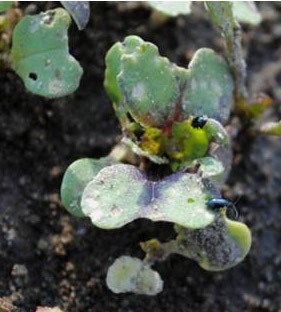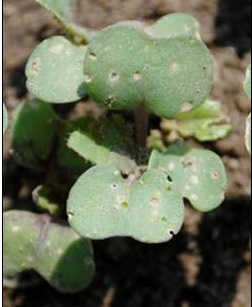Flea beetles in crucifer crops
Learn how to identify, biology of, and management options for flea beetles in crucifer crops.
What species of flea beetles affect crucifer crops in Ontario?
Two species of flea beetles that commonly feed on brassica crops in Ontario are the crucifer flea beetle (Phyllotreta cruciferae) and striped flea beetle (Phyllotreta striolata). There are reports that the crucifer flea beetle is more common in Ontario than the striped flea beetle.
Biology of flea beetles
In Ontario, both flea beetles have one generation per year. Adults overwinter in soil and leaf litter and become active the following spring (usually in May). Striped flea beetles typically become active two weeks earlier than the crucifer flea beetle, but you can usually find these species co-existing in the same field. Soon after the beetles become active in the spring, they lay eggs in soil near host plants. These eggs hatch in about 5 days and the larvae undergo three instars (or stages) followed by pupation in the soil. Adults emerge in July and feed until they need to seek hibernation sites in the fall to overwinter. In hot, dry weather (ideal conditions), development from egg to adult can take place in as little as 7 weeks, as such there is the potential for 2 generations per year here. Flea beetles will also consume cruciferous weed species. Sunny, warm, dry conditions are ideal conditions for flea beetle feeding. Feeding activity decreases when conditions are cool and damp.
How do you identify flea beetles?
Flea beetles are small, 2-3 mm long, shiny black beetles with strong hindlegs. When you approach plants infested with flea beetles, the beetles will jump away quickly. When you see this behaviour you can understand why they are called "flea" beetles. The striped flea beetles are brownish-black in colour with yellow stripes down their backs (Figure 1A). Crucifer flea beetles are black and very shiny (Figure 1B).
What does flea beetle feeding damage look like and how does it affect the plant?
Feeding damage is described as small round holes or 'shot-holes' on the leaves of crucifer crops. Older feeding holes may be ringed with dried, brown tissue, while newer feeding holes are surrounding by green tissue (Figure 3; you can see both old and new damage on these young leaves). Damage may also appear as small pits on the leaves. Flea beetles can cause enough foliage damage to seedlings resulting in death. Direct-seeded crops and young tender transplants are quite susceptible to damage. Brassica transplants seem to be less susceptible to flea beetle damage compared to direct-seeded crops and these beetles prefer specialty Brassica crops, like Chinese cabbage, bok choy, compared to the 'traditional' cole crops (broccoli, cabbage, cauliflower). Plants can tolerate no more than 1 flea beetle/plant up to the 6th leaf stage. Generally, after the 6th leaf stage there is enough leaf tissue that plants can tolerate damage, which may otherwise interfere with growth at earlier crop stages.
Management options for flea beetles
Use transplants, if possible. Flea beetles can cause significant damage on seedlings of direct-seeded crops. Using transplants can give you head start against flea beetles. Control cruciferous weeds to reduce potential feeding sites in the spring.
Floating row covers may help, but keep in mind that crop rotation is important. If you are planting in the same area of the field that had crucifer crops last year, the flea beetles could potentially be trapped with your crop under the row cover this spring. Row covers need to be installed with sealed edges soon after planting to prevent infestations of flea beetles. Row covers may interfere with growth of cole crops. Be sure to check under the covers for the presence of flea beetles (and other pests) and to see how your crop is growing under cover.
Pest control products may help manage populations of flea beetles. When scouting, inspect 25 plants throughout the field. For newly emerged or transplanted crops, you may need to check the fields every couple days, as flea beetles can cause significant damage during this stage the crop. Flea beetles will try to jump away when you are walking through the crop, so try to make counts as you approach the plants.
Record the number of beetles on each plant and divide by 25 to calculate the average number of beetles per plant. Make notes on the feeding damage caused by flea beetles, as well. In terms of treatment thresholds, up to the 6-leaf stage, plants can tolerate no more than one flea beetle per plant; however, feeding damage incurred in later growth stages may negatively impact the quality and thus the marketability of the crop (this is particularly a concern for the 'leafy' brassica vegetables).
Refer to Publication 838, Vegetable Crop Protection Guide and supplement for more information on pest control products registered for flea beetles. Always follow directions for use and precautions on the product label. More information on flea beetles is on the CropIPM website.


